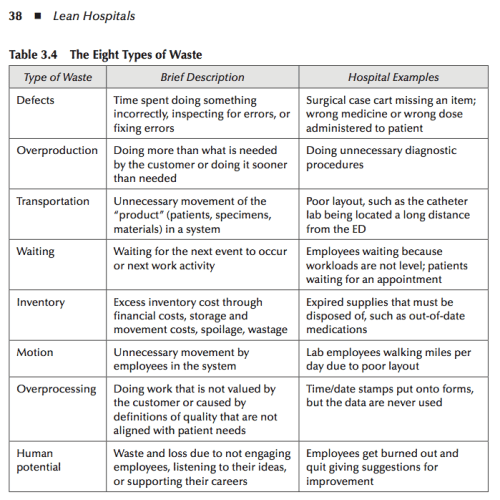tl;dr: In this post, Mark provides an in-depth look at the eight types of waste in healthcare, including defects, overproduction, waiting, non-utilized talent, transportation, inventory, motion, and extra-processing. He dissects each type and highlights their implications for patient care, operational efficiency, and employee morale. Using Lean principles as a foundation, Mark advocates for targeted strategies to identify and eliminate these wastes for a more streamlined and effective healthcare system.
From the book Lean Hospitals: Improving Quality, Patient Safety, and Employee Engagement…
The types of waste:
- Defects
- Overproduction
- Transportation
- Waiting
- Inventory
- Motion
- Overprocessing
- Human potential

What is Waste? (Book Excerpt, 3rd Edition)
What are the problems and annoyances that constantly appear, interfering with our work and the best patient care? In Lean, we call this waste. Dr. Berwick describes waste as a “needless hassle” and “what does not make sense in our health care system.”[i]
Hospital workdays are full of interruptions, miscommunications, wasted motion, and workarounds. Employees and leaders often think their job, or the value they bring to an organization, is their ability to put up with problems or to fight fires. When supplies are missing, we run to find them. When our workspaces are badly designed, and workloads are high, we walk faster and try harder. When orders do not arrive from a physician's office, we make multiple phone calls to track them down. It's good, in a way, that people make this effort. But they shouldn't have to. These extra efforts do not prevent the same problem from reoccurring. Instead of pointing at workarounds and heroic measures as “our job,” we might do better by viewing waste as something to reduce or eliminate, so we can spend more time doing our real work–caring for patients.
Learning to separate motion (the things we do) from value (the things we do that help the patient) is a critical step in the Lean journey. Instead of defining our jobs in terms of “this is what we do” or “this is how we've always done it,” Lean gives us a framework for determining what we should be doing and how we should be doing it. Hospitals can learn how to free up time in ways that do not cut corners on quality of care that is needed by the patient.
Hospital employees typically spend a high percentage of their time on wasteful activities. For example, medical/surgical nurses in hospitals around the world typically spend only about 30% of their time on direct patient care, including
- Nursing procedures
- Hygiene and toileting
- Administering medication
- Giving medical guidance
And the studies that generated those results were done before the widespread adoption of electronic medical record (EMR) systems. EMR systems may solve some problems, but new technologies sometimes create new forms of waste and keep providers away from the bedside even more than before.
Seattle's Virginia Mason Medical Center has used Lean methods to increase nursing time at the bedside from about 33% to 90%.[ii] The National Health Service in the United Kingdom has taught Lean methods to nurses and hospital staff through its Releasing Time to Care program.[iii] On average, time at the bedside increased from 35% to 55% across 19 NHS Scotland hospitals that implemented the program.[iv]. Hospitals in the United States are using a similar approach called Transforming Care at the Bedside (TCAB), which sets a goal of increasing bedside time from 30% to 70%. One system that adopted TCAB reported the time nurses spent in patient rooms increased from 2.5 hours in a 12-hour shift to 6.5 hours, resulting in a 32% reduction in falls and a 17% reduction in medication errors. Nurse turnover rates in TCAB hospitals fell by nearly 20%, suggesting that an environment with less waste and more time for patient care is more rewarding for staff.[v]
When employees, departments or hospitals are overworked, we need to reduce waste instead of just asking for more resources and people. Reducing waste, by improving processes, also allows us to take on more work without adding pepople, doing so in a way that does not stress our employees. Reducing waste also provides time for people to do their work the right way–providing high-quality and great service to patients instead of being pressured to cut corners due to a lack of time. Eliminating waste allows us to reduce costs, provide more service, improve quality, and improve employee satisfaction–it is good for all of our hospital stakeholders.
To help identify waste, having specific shared terminology can help. Ohno defined seven types of waste, while later publications often listed eight types.[i] These definitions have been adopted as a useful framework for viewing waste in hospitals. Sometimes, the terms are used verbatim; sometimes, they are modified. Having complete agreement on the exact terms is not crucial, as Toyota did not intend this list to be all inclusive or to be something that could not be changed. Consistent terminology does, however, help us communicate within our organization and across the industry.
[i] Liker, Jeffrey K., The Toyota Way: 14 Management Principles from the World's Greatest Automaker (New York: McGraw-Hill, 2004), 28-29.
[i] Fleming.
[ii] Kenney, Charles, Transforming Healthcare: Virginia Mason Medical Center's Pursuit of the Perfect Patient Experience (New York: Productivity Press, 2010), 122.
[iii] National Health Service, “The Productive Ward: Releasing Time to Care,” http://www.institute.nhs.uk/quality_and_value/productive_ward/case_studies.html (accessed March 26, 2015).
[iv] Health Improvement Scotland, “Releasing Time to Care,Making our Priorities Possible, Final Report,” http://www.healthcareimprovementscotland.org/his/idoc.ashx?docid=091a7fae-3f68-4606-b1b0-7e98278ac7b2&version=-1 (accessed September 15, 2015).
[v] Zimlich, Rachael, “Hospitals resolve to increase nurses' time at the bedside,”
http://healthcaretraveler.modernmedicine.com/healthcare-traveler/content/modernmedicine/modern-medicine-feature-articles/hospitals-resolve-increa?page=full (accessed September 12, 2015).




![When Was the Last Time a Leader Around You Admitted They Were Wrong? [Poll]](https://www.leanblog.org/wp-content/uploads/2025/07/Lean-Blog-Post-Cover-Image-2025-07-01T212509.843-100x75.jpg)
